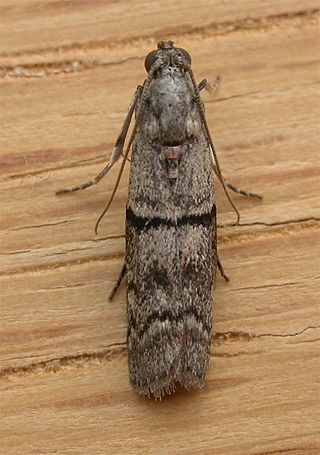
The United States of America, commonly known as the United States or America, is a country primarily located in North America, between Canada and Mexico. It is a federation of 50 states, a federal capital district, and 326 Indian reservations. Outside the union of states, it asserts sovereignty over five major unincorporated island territories and various uninhabited islands. The country has the world's third-largest land area, largest maritime exclusive economic zone, and the third-largest population, exceeding 334 million.

Oncocera semirubella, the rosy-striped knot-horn, is a small moth of the family Pyralidae.

The Acleistoceratidae is a family of oncocerids that contains genera characterized by depressed exogastric brevicones and cyrtocones that range from the Middle Silurian to the Middle Devonian. The siphuncle is broadly expanded, and in some actinosiphonate.

Oncoceratidae is a family of nauatiloid cephalopods in the order Oncocerida established by Hyatt, 1884, that range from the Middle Ordovician to the Upper Silurian.
Diestoceratidae is a family in the nautiloid cephalopod order Oncocerida with compressed, straight to faintly endogastic breviconic shells with a marginal siphuncle that contains discrete, irregular actinosphonate deposits.

The Phycitinae are a subfamily of snout moths. Even though the Pyralidae subfamilies are all quite diverse, Phycitinae stand out even by standards of their family: with over 600 genera considered valid and more than 4000 species placed here at present, they unite up more than three-quarters of living snout moth diversity. Together with the closely related Epipaschiinae, they are apparently the most advanced lineage of snout moths.
Alophia is a monotypic snout moth genus described by Émile Louis Ragonot in 1893. Its single species, Alophia combustella, was described by Gottlieb August Wilhelm Herrich-Schäffer in 1852. It is found in Spain, Portugal, France, Italy, Sardinia, Sicily, Greece, North Macedonia, Croatia, Hungary, Romania, Ukraine and southern Russia.
Simardoceras is a genus in the discosorid family Westonoceratidae from the Middle Ordovician of Quebec.

The Phycitini are a tribe of moths of the family Pyralidae.

Laodamia is a genus of snout moths. It is sometimes listed as a subgenus of Oncocera.

Oncocera is a genus of snout moths. It was described by James Francis Stephens in 1829.
Cyrtogomphoceras is a genus of nautiloid cephalopods, recognized by its large breviconic shell with a notable endogastric curvature. The shell is fusiform in profile, reaching maximum width at or near the base of body chamber, which narrows toward the aperture. The siphuncle is large and slightly removed from the ventral side, that with the concave longitudinal profile. Siphuncle segments are short, as are chambers; septal necks recurved, connecting rings thick, bullettes at the apical end of the rings swollen. Cameral deposits are lacking.

Borys Ivanovych Balinsky was a Ukrainian- South African biologist, embryologist, entomologist.
Maelonoceras is a Late Ordovician - early Silurian oncocerid found in Ontario.








